Prompt engineering is an important aspect for making AI models work well. Different tools have come out to assist users in making, organizing, and improving prompts for various AI tasks. This article gives a deep look at some top prompt engineering tools. It explains their main features, how they are used, and gives examples to illustrate their use with their pricing details to it.
What is Prompt Engineering?
Why is Prompt Engineering Important?

Prompt engineering is essential for maximizing the utility of AI models. Well-crafted prompts can significantly improve the accuracy, relevance, and creativity of AI-generated content. Here are some reasons why prompt engineering is crucial:
-
Enhancing AI Performance
Properly designed prompts can guide AI models to produce high-quality outputs, reducing the need for extensive post-processing or corrections.
-
Increasing Efficiency
Effective prompts streamline the content generation process, saving time and effort for users. This is particularly beneficial for applications like automated writing, customer support, and data analysis.
-
Enabling Customization
Key Components of Prompt Engineering
- Prompt Design: Creating clear and precise prompts to instruct the AI on what you want. This involves selecting the appropriate words and structure to direct the model effectively.
- Prompt Refinement: Testing and tweaking prompts repeatedly to get better AI responses. This involves trying different words and formats to find what works best.
- Contextualization: Giving enough context in the prompt so the AI understands the task. This can include background information, examples, or specific instructions.
- Optimization: Using techniques and tools to improve prompts for consistent and accurate results. This includes using prompt engineering tools, feedback from others, and performance analysis.
Best Tools list for Prompt Engineering
1. BetterPrompt
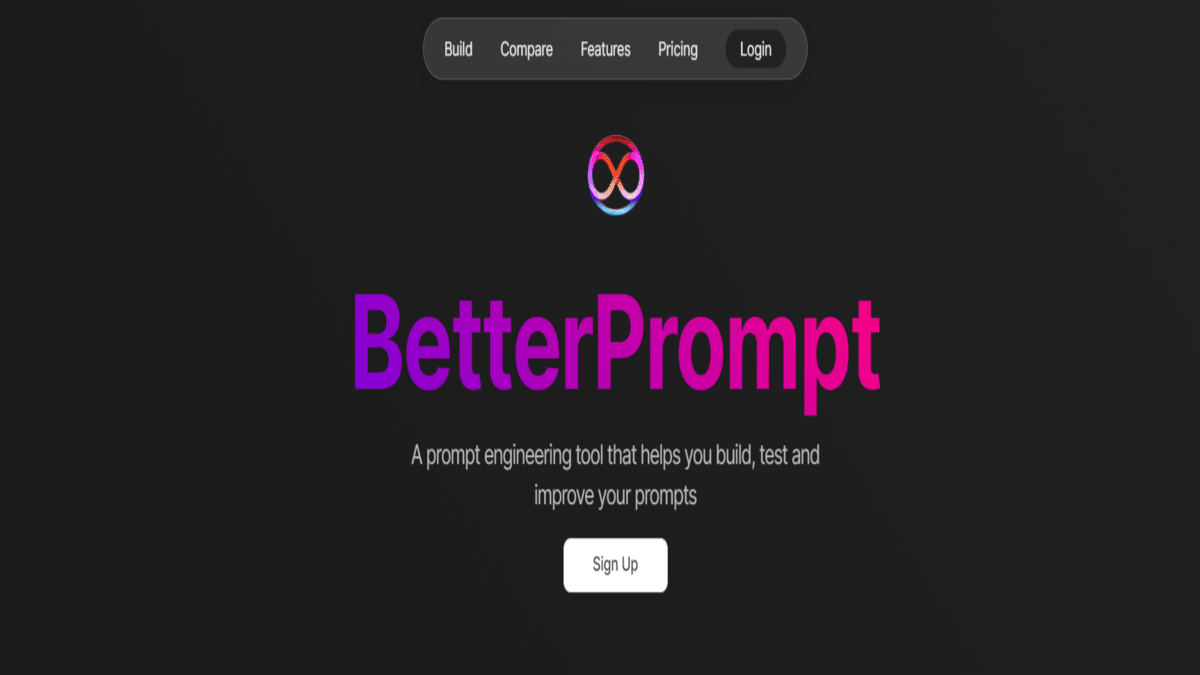
BetterPrompt is a tool that helps you create and manage prompts for AI models. It offers a library of pre-made prompts, allows you to create and save your own, and lets you share prompts with the community for feedback. This tool is useful for tasks like training AI models, generating content, and educational purposes.
Key Features
- Prompt Library: Offers a wide range of pre-designed prompts.
- Custom Prompt Creation: Allows users to create and save their own prompts.
- Community Sharing: Users can share prompts within the community and get feedback.
Pricing Details:
See BetterPrompt Pricing Details
Pros:
- Easy to Use: User-friendly interface makes it simple to create and manage prompts.
- Prompt Library: Access to a variety of pre-made prompts to get you started quickly.
- Customization: Allows you to create and save your own prompts tailored to your specific needs.
Cons:
- Dependence on Community: The quality and variety of prompts can depend on how active the user community is.
- Performance Variation: The effectiveness of prompts can vary based on the AI model being used.
- Internet Connection Required: Needs an internet connection to access the prompt library and community features.
Use Cases
- AI Model Training: Helps in designing effective prompts for training AI models.
- Content Generation: Useful for generating creative content by providing structured prompts.
- Educational Purposes: Aids in teaching prompt engineering concepts.
Example
A user creating a prompt to generate a marketing email for a new product launch can utilize BetterPrompt’s library to find relevant templates and customize them according to their needs.
2. AIPRM
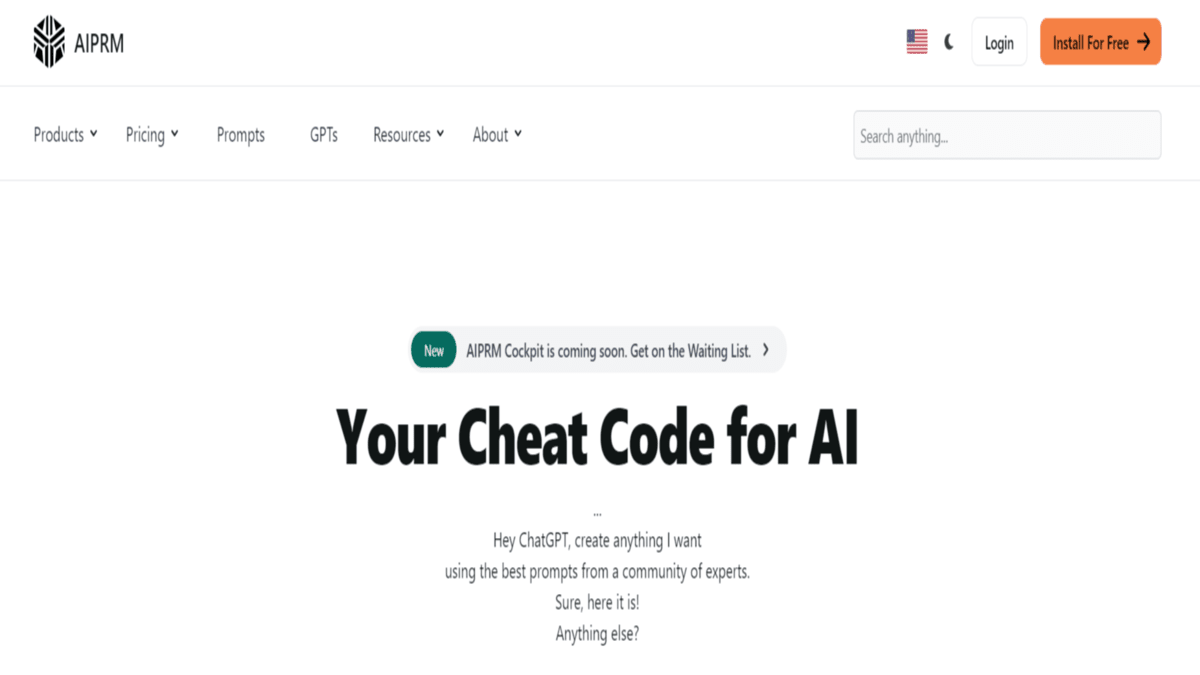
AIPRM is a tool designed to help users create optimized prompts for AI models, specifically focusing on SEO and digital marketing content. It provides prompts tailored for search engine optimization, integrates with various AI assistants, and offers analytics to track prompt performance. AIPRM is particularly useful for marketers, content creators, and data analysts who want to enhance their online presence and content effectiveness.
Key Features
- SEO Optimization: Provides prompts specifically designed for SEO content.
- AI Assistant Integration: Integrates with various AI assistants to enhance their capabilities.
- Analytics and Insights: Offers insights into prompt performance and effectiveness.
Pricing Details:
AIPRM: See AIPRM Pricing Details
Pros:
- SEO Optimization: Helps in creating prompts that improve search engine rankings for content.
- Integration with AI Assistants: Allows integration with various AI tools to enhance capabilities.
- Analytics: Offers analytics for monitoring and enhancing prompt performance.
- Customization: Offers tailored prompts for specific marketing and content creation needs.
Cons:
- Cost: Advanced features may require a paid subscription, which can be costly for some users.
- Learning Curve: Might take time to fully understand and utilize all its features effectively.
- Dependence on AI Models: Effectiveness of prompts can vary depending on the AI models integrated with.
Use Cases
- SEO Content Creation: Helps in creating optimized content for better search engine ranking.
- Digital Marketing: Assists in generating marketing content tailored to specific audiences.
- Data Analysis: Provides prompts for analyzing and interpreting data.
Example
A digital marketer using AIPRM to generate SEO-friendly blog posts can leverage its optimization features to improve their content’s visibility on search engines.
3. Promptbase
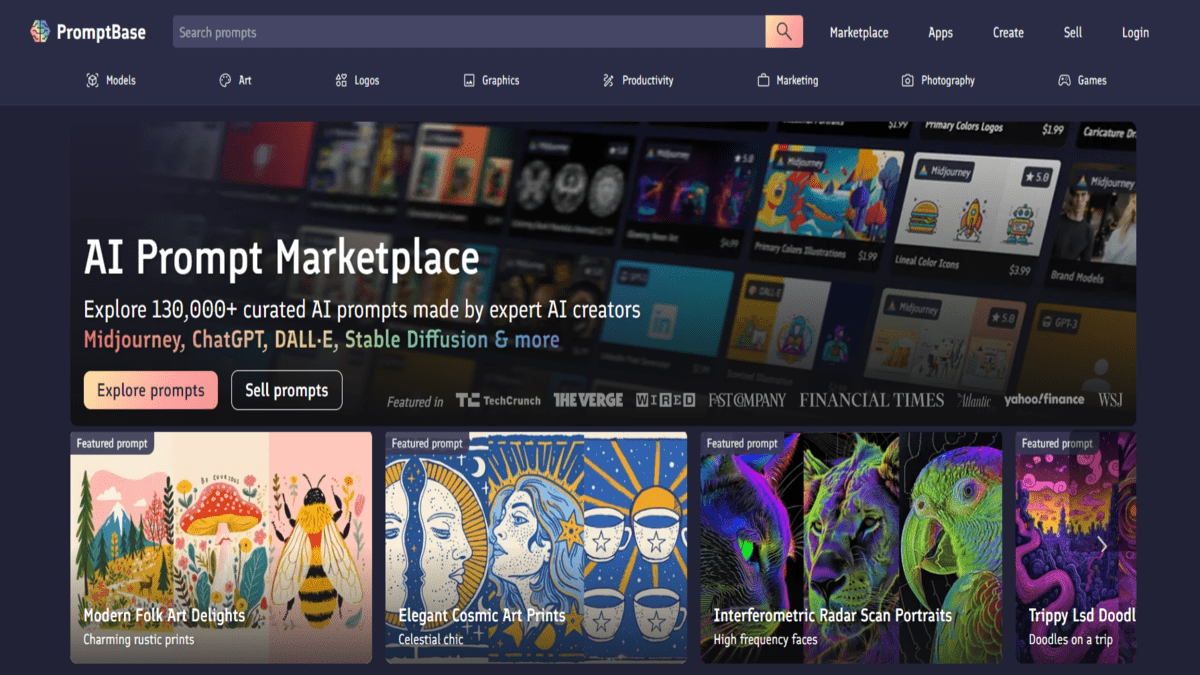
Promptbase is a platform designed for creating and managing prompts for AI models. It operates as a marketplace where users can purchase and sell prompts, maintaining quality assurance through a rigorous review process. Promptbase also offers custom prompt creation services, making it a versatile tool for individuals and businesses looking to enhance their AI interactions with tailored inputs.
Key Features
- Marketplace for Prompts: A platform where users can buy and sell prompts.
- Quality Assurance: Ensures high-quality prompts through a review process.
- Custom Solutions: Offers personalized prompt creation services.
Pricing Details:
Promptbase: Custom Pricing
Pros:
- Prompt Marketplace: Provides a marketplace for buying and selling prompts, offering a wide variety of options.
- Quality Assurance: Ensures high-quality prompts through a review process, enhancing reliability.
- Customization: Offers custom prompt creation services tailored to specific needs.
- Community Interaction: Facilitates collaboration and feedback among users, improving prompt quality over time.
Cons:
- Dependency on Community: The availability and variety of prompts can depend on the active participation of the user community.
- Performance Variability: Effectiveness of prompts may vary depending on the AI models and applications used.
- Internet Access: Requires an internet connection to access and utilize the platform and its features fully.
Use Cases
- Freelancers and Agencies: Allows freelancers and agencies to monetize their prompt engineering skills.
- Businesses: Enables businesses to purchase tailored prompts for specific applications.
- Educational Tools: Serves as a resource for learning prompt engineering.
Example
An agency can purchase prompts from Promptbase to create customized AI-driven content for their clients, enhancing efficiency and quality.
4. Writesonic (Chatsonic Prompt Marketplace)

Writesonic is an AI-powered platform designed to assist with content creation by generating text based on user-provided prompts. It features a variety of prompt categories such as marketing, education, and more. Writesonic integrates with Chatsonic, its AI writing assistant, to help users create high-quality content efficiently. This tool is beneficial for writers, marketers, educators, and others looking to streamline their content creation process using AI technology.
Key Features
- Diverse Prompt Categories: Offers prompts for various domains such as marketing, education, and more.
- AI Writing Assistant: Integrated with Chatsonic to assist in content creation.
- User-Friendly Interface: Easy-to-use platform for creating and managing prompts.
Pricing Details:
Writesonic: See Writesonic Pricing Details
Pros:
- AI-Powered Content Generation: Utilizes AI to produce text from user prompts, streamlining tasks and saving time.
- Wide Range of Prompt Categories: Offers prompts tailored for various needs such as marketing, education, and more.
- User-Friendly Interface: User-friendly platform that streamlines content creation effortlessly.
- Integration with Chatsonic: Utilizes Chatsonic, an AI writing assistant, to enhance content quality and productivity.
Cons:
- Content Quality Variation: Generated content may vary in quality and may require editing for accuracy and style.
- Dependence on AI Models: Effectiveness of content generation depends on the capabilities and accuracy of the underlying AI models.
- Learning Curve: Beginners might require time to get acquainted with the platform and maximize prompt utilization.
Use Cases
- Content Writers: Assists writers in generating high-quality content efficiently.
- Social Media Managers: Helps in creating engaging social media posts.
- Students and Educators: Aids in academic writing and learning.
Example
A content writer using Writesonic can quickly generate article outlines and drafts, significantly reducing the time required for content creation.
5. Prompthero

Prompthero is a platform designed to assist users in generating prompts for various applications, particularly focusing on enhancing creativity and efficiency in content creation and AI model training. It offers an extensive library of prompts across different categories and encourages community interaction for sharing and refining prompt ideas. Prompthero is beneficial for writers, AI developers, researchers, and educators seeking innovative ways to utilize AI-driven prompt generation for their projects and tasks.
Key Features
- Prompt Library: Extensive library of prompts for various applications.
- Community Interaction: Allows users to collaborate and share prompts.
- Customizable Prompts: Users can modify prompts to suit their specific needs.
Pricing Details:
PromptHero: Custom Pricing
Pros:
- Extensive Prompt Library: Offers a wide range of prompts across different categories, providing options for various applications.
- Community Interaction: Facilitates collaboration and feedback among users, improving prompt quality and creativity.
- Educational Value: Useful for educators and students to learn about prompt engineering and AI applications.
Cons:
- Quality Control: The quality and effectiveness of prompts may vary depending on community contributions and updates from the platform.
- Learning Curve: New users may require time to explore and understand how to utilize the platform effectively.
Use Cases
- Creative Writing: Enhances creative writing by providing structured prompts.
- AI Training: Facilitates training AI models with diverse prompts.
- Research: Supports research activities by generating data analysis prompts.
Example
A researcher can use Prompthero to create prompts for analyzing survey data, streamlining the research process.
6. Agenta
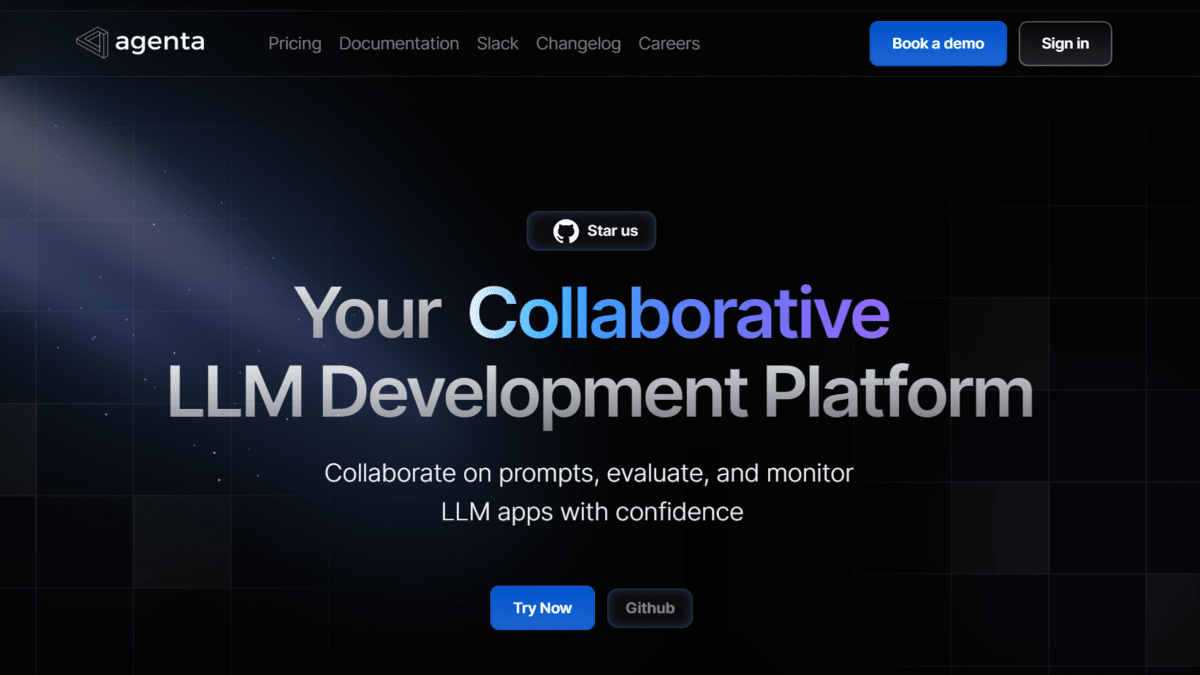
Agenta is a platform designed to integrate with various AI models and assist in generating prompts and responses dynamically. It focuses on enhancing interactions through AI-driven responses, making it suitable for applications like customer support, product development, and marketing strategies. Agenta aims to optimize user engagement and operational efficiency by leveraging AI technologies for prompt generation and real-time interaction management.
Key Features
- AI Integration: Seamlessly integrates with various AI models.
- Dynamic Prompt Generation: Generates prompts dynamically based on user input.
- User Analytics: Provides insights into how prompts are being used and their effectiveness.
Pricing Details:
Agenta: See Agenta Pricing Details
Pros:
- AI Integration: Integrates seamlessly with various AI models to enhance prompt generation and response capabilities.
- Dynamic Prompt Generation: Generates prompts and responses dynamically based on user input and context, improving interaction quality.
- Real-Time Interaction Management: Facilitates real-time management of AI-driven interactions, enhancing customer support and operational efficiency.
Cons:
- Dependency on AI Models: Effectiveness of prompts and responses can vary based on the integration and performance of underlying AI models.
- Internet Dependency: Requires a stable internet connection to access and utilize the platform’s features fully.
- Integration Complexity: Integration with existing systems or workflows may require technical expertise, posing challenges for some users.
Use Cases
- Customer Support: Enhances customer support systems by providing dynamic responses.
- Product Development: Aids in generating ideas for product features and improvements.
- Marketing Strategies: Helps in formulating effective marketing strategies through prompt analysis.
Example
A customer support team using Agenta can generate real-time responses to customer queries, improving response times and customer satisfaction.
7. Promptpal

PromptPal is a software tool designed to assist users in managing and creating prompts for various applications, particularly in the context of improving AI interactions and content generation. It provides a user-friendly interface where users can input prompts and receive tailored outputs from AI models. PromptPal aims to streamline prompt engineering processes, enhance productivity, and facilitate the customization of prompts for specific tasks and projects.
Key Features
- Prompt Curation: Curates high-quality prompts from various sources.
- Collaboration Tools: Enables team collaboration on prompt creation.
- Prompt Templates: Provides a wide range of templates for different use cases.
Pricing Details:
Promptpal: See Promptpal Pricimg Details
Pros:
- User-Friendly Interface: Provides a straightforward interface that simplifies prompt creation and management.
- Customization: Allows users to customize prompts for specific applications and tasks.
- Enhanced AI Interactions: Improves AI model interactions by providing well-crafted prompts.
- Productivity: Streamlines prompt engineering processes, saving time and effort.
Cons:
- Cost: Advanced features or full functionality may require a paid subscription, potentially limiting access for some users.
- Learning Curve: New users may need time to understand all features and optimize their use effectively.
- Dependency on AI Models: Effectiveness of prompts depends on the capabilities and accuracy of the underlying AI models.
Use Cases
- Team Projects: Facilitates collaboration on projects requiring prompt engineering.
- Educational Purposes: Serves as a teaching tool for prompt engineering courses.
- Business Solutions: Offers customized prompts for business applications.
Example
An educational institution can use Promptpal to create collaborative assignments for students, enhancing their learning experience.
8. Saasprompt

SaasPrompt is a platform designed to assist users in generating prompts for AI models, particularly focusing on software as a service (SaaS) applications. It provides tools and resources to create, manage, and optimize prompts for various AI-driven tasks, such as content creation, customer support, and data analysis. SaasPrompt aims to enhance user productivity and efficiency by offering customizable prompt solutions tailored to specific business needs and applications.
Key Features
- SaaS Integration: Integrates with various SaaS platforms.
- Prompt Optimization: Provides tools for optimizing prompts for better performance.
- User Community: Active community for sharing and discussing prompts.
Pricing Details:
SaaSPrompt: See SaaSPrompt Pricing Details
Pros:
- Tailored for SaaS Applications: Specifically designed for software as a service (SaaS) environments, catering to diverse business needs.
- User-Friendly Interface: Provides an intuitive platform that simplifies prompt management and optimization.
- Integration: Integrates well with existing SaaS workflows and applications.
- Customizable Prompts: Offers tools to create and customize prompts tailored to specific AI applications and tasks.
Cons:
- Cost: Advanced features or full functionality may require a paid subscription, potentially limiting access for some users.
- Learning Curve: New users may need time to understand all features and optimize their use effectively.
- Integration Complexity: Integration with existing workflows or systems may require technical expertise, posing challenges for some users.
Use Cases
- SaaS Companies: Helps in creating prompts for customer interactions.
- Tech Startups: Assists in developing AI-driven solutions for startups.
- Data Analysis: Generates prompts for analyzing SaaS platform data.
Example
A SaaS company can use Saasprompt to develop prompts for their customer service chatbot, improving customer engagement.
9. Learnprompting
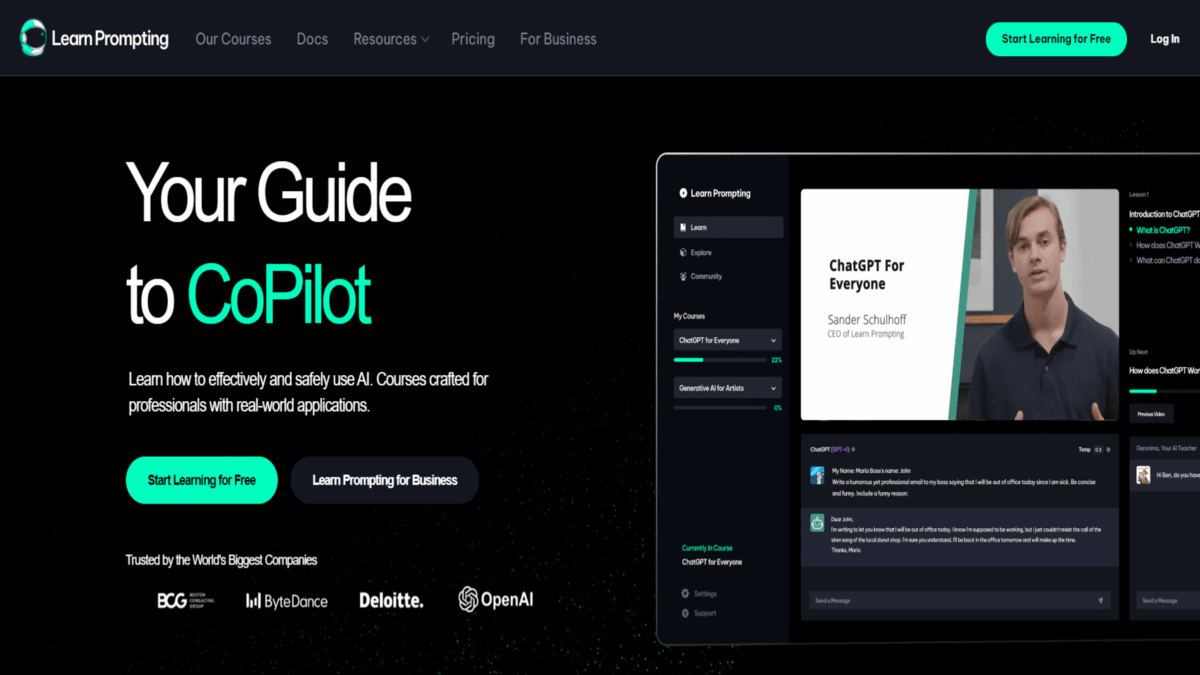
LearnPrompting is an educational platform or resource focused on teaching and training individuals in the art and science of prompt engineering. It likely offers courses, tutorials, or materials aimed at helping users understand how to effectively create, refine, and optimize prompts for AI models. LearnPrompting may cover various aspects of prompt engineering, including techniques, best practices, and practical applications across different industries and use cases involving artificial intelligence.
Key Features
- Educational Resources: Offers tutorials and guides on prompt engineering.
- Interactive Learning: Provides interactive exercises and quizzes.
- Community Support: Active community for peer support and knowledge sharing.
Pricing Details:
Learnprompting:See LaernPrompting Pricing Details
Pros:
- Educational Resource: Provides comprehensive learning materials and resources focused on prompt engineering.
- Skill Development: Helps users acquire skills in creating, refining, and optimizing prompts for AI models.
- Practical Applications: Offers insights and best practices applicable to various industries and AI-driven tasks.
Cons:
- Accessibility: Availability and comprehensiveness of resources may vary, potentially limiting access for some learners.
- Learning Curve: Some users may find certain concepts or techniques challenging to grasp initially.
- Dependence on Updates: Quality and relevance of content may depend on updates and contributions from the platform.
Use Cases
- Students and Educators: Ideal for learning and teaching prompt engineering.
- AI Enthusiasts: Helps enthusiasts improve their prompt engineering skills.
- Professional Development: Aids professionals in staying updated with the latest prompt engineering techniques.
Example
A student can use Learnprompting to access tutorials and practice exercises, enhancing their understanding of prompt engineering concepts.
10. Promptperfect

Promptperfect is a platform focused on providing tools and solutions for prompt engineering, particularly in the context of enhancing interactions with AI models. It offers resources and capabilities to create, manage, and optimize prompts for various applications such as content generation, customer service, and data analysis. Promptperfect aims to improve the effectiveness and efficiency of AI-driven tasks by offering customizable prompt solutions tailored to specific business needs and objectives.
Key Features
- Prompt Refinement: Tools for refining and improving prompts.
- Performance Tracking: Tracks the performance of prompts over time.
- AI Model Compatibility: Compatible with various AI models for versatile use.
Pricing Details:
Promptperfect: See PromptPerfect Pricing Details
Pros:
- Prompt Engineering Tools: Provides tools and solutions specifically designed for prompt engineering, enhancing interactions with AI models.
- Customization: Allows users to create, manage, and optimize prompts tailored to specific applications and tasks.
- Enhanced AI Interactions: Improves the effectiveness and efficiency of AI-driven tasks such as content generation, customer service, and data analysis.
Cons:
- Dependency on AI Models: Effectiveness of prompts depends on the capabilities and accuracy of the underlying AI models.
- Internet Access: Requires an internet connection to access and utilize the platform, which may be a limitation in certain environments.
- Integration Complexity: Integration with existing workflows or systems may require technical expertise, posing challenges for some users.
Use Cases
- AI Developers: Assists in developing and refining prompts for AI applications.
- Businesses: Helps businesses optimize prompts for customer interactions.
- Researchers: Provides tools for creating and testing research-related prompts.
Example
An AI developer can use Promptperfect to refine prompts for a virtual assistant, ensuring more accurate and relevant responses.
Choosing the right prompt engineering software for business
By following these steps, you can find prompt engineering software that enhances your business operations and helps achieve your goals efficiently.
- Define Needs: First, understand why you need the software—whether it’s for writing content, helping customers, or analyzing data.
- Features Checklist: List the features you need, like customization options, integration with other tools, and ease of use.
- Research Options: Look into different software options available. Review feedback and seek recommendations from peers in your industry.
- Try Before You Buy: Take advantage of free trials or demos to see how the software works and if it fits your needs.
- Consider Support and Security: Check the level of customer support offered and ensure the software meets security standards.
- Cost Evaluation: Compare costs with the benefits the software offers to determine if it’s worth the investment.
- Make an Informed Decision: Based on your research and trials, choose the software that best meets your requirements and budget.
The Future of Prompt Engineering Software
Prompt engineering software will play a crucial role in enhancing AI interactions and improving efficiency across various industries in the future.
- Enhanced Customization: Software will offer more tailored prompts, adapting better to specific tasks and user needs.
- Integration with AI: Deeper integration with AI models will improve accuracy and responsiveness in generating prompts.
- Automation: More automation in prompt creation will streamline workflows and increase productivity.
- Improved Analytics: Advanced analytics will provide insights into prompt effectiveness, helping to refine and optimize outputs.
- User-Friendly Interfaces: Interfaces will become more intuitive, making it easier for users to create and manage prompts efficiently.
- Expanded Applications: Prompt engineering software will find applications in diverse fields, from healthcare and education to marketing and beyond.
Conclusion
Prompt engineering tools play a crucial role in enhancing the capabilities of AI models. Each tool offers unique features and use cases, catering to different needs and applications. Whether you’re a content creator, marketer, researcher, or AI enthusiast, these tools can significantly improve your prompt engineering skills and outcomes. Explore these tools to find the one that best suits your requirements, and start optimizing your AI interactions today.
FAQs
These FAQs provide the importance, functionality, and selection criteria for prompt engineering tools, helping businesses make informed decisions in 2024.
1. What is prompt engineering software?
Ans. Prompt engineering software helps users create and manage prompts that guide AI models to produce specific outputs. It optimizes interactions and enhances AI performance in various applications.
2. What are the key features to look for in prompt engineering tools?
Ans. Key features include customization options for prompts, integration capabilities with AI models, analytics for performance tracking, ease of use, and compatibility with existing workflows.
3. Which industries benefit most from prompt engineering tools?
Ans. Industries such as marketing, customer service, healthcare, education, and data analytics benefit significantly from prompt engineering tools to improve efficiency and accuracy in AI-driven tasks.
4. How do prompt engineering tools improve AI model performance?
Ans. These tools refine the inputs (prompts) provided to AI models, ensuring they receive clear and relevant instructions. This optimization leads to more accurate and reliable outputs from the AI.
5. Are prompt engineering tools easy to use for non-technical users?
Ans. Many prompt engineering tools offer user-friendly interfaces and intuitive features, making them accessible to non-technical users. Training resources and support are often provided to assist in learning.
6. What are some examples of popular prompt engineering tools in 2024?
Ans. Examples include BetterPrompt, DeepSwap, Cupace, Writesonic, PromptHero, AIPRM, Agenta, PromptPal, SaasPrompt, and LearnPrompting.
7. How can prompt engineering tools benefit small businesses?
Ans. These tools can help small businesses enhance productivity, improve customer interactions, streamline content creation, and optimize data analysis, all while reducing operational costs.
8. What factors should businesses consider when choosing a prompt engineering tool?
Ans. Businesses should consider factors such as their specific needs, budget, integration capabilities with existing systems, customer support quality, security features, and scalability.
9. Do prompt engineering tools require internet connectivity?
Ans. Yes, most prompt engineering tools require an internet connection to access cloud-based features, updates, and to utilize AI models for prompt generation and analysis.
10. How can businesses measure the ROI of using prompt engineering tools?
Ans. ROI can be measured by evaluating improvements in efficiency, accuracy of AI-generated outputs, cost savings from automated tasks, and enhanced customer satisfaction metrics resulting from prompt engineering tools.

